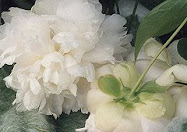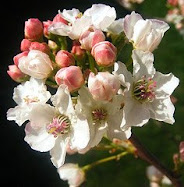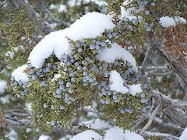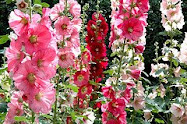 Having written of the perils of toxins in common garden plants a couple weeks ago, it's only fair and balanced to take another meander down the garden path, this time to highlight garden healers and promoters of good health. Gardening in and of itself confers benefits in vim, vigor and fitness of mind and body to the practitioner, but beyond those gains it also contains plant genuses which actively heal, soothe and remedy specific afflictions. Let's consider just a few of the most efficacious.
Having written of the perils of toxins in common garden plants a couple weeks ago, it's only fair and balanced to take another meander down the garden path, this time to highlight garden healers and promoters of good health. Gardening in and of itself confers benefits in vim, vigor and fitness of mind and body to the practitioner, but beyond those gains it also contains plant genuses which actively heal, soothe and remedy specific afflictions. Let's consider just a few of the most efficacious.Garlic literally leaps to mind ahead of all comers in the plant world pharmacopoeia. Research has demonstrated that it helps prevent the occurrence of cancers in the body. Eaten raw and daily, it purges and cleanses the lungs (this one's for you, dear smokers). It will also ameliorate and forestall the recurrence of chronic cold sores, fever blisters, impetigo, hemorrhoids and chronic rashes, as well as battle acne into submission and enhance skin tone. It's able to settle upset stomachs and fend off Monteczuma's revenge (or diarrhea if you're outside Mexico), through it's very able anti-bacterial properties. A couple cloves a day of fresh garlic chopped fine, swallowed like a pill before eating, and washed down with a slug of milk to help mask any odor kickback, will accomplish all these curative feats. This homeopathic remedy is also probably the easiest in creation to be homegrown, as just pushing whole garlic cloves a couple inches down into good soil or compost in a sunny spot will yield new green shoots in about two weeks. When the leaves begin to brown and fall over, the garlic cloves are ripe for harvest.
Peppermint or spearmint, another plant genus that is only too eager to flourish in the garden, also puts a fast halt to stomach upsets, and the stomach-muscle spasms and other symptoms of norovirus infection. A tisane or tea of any type of mint leaves works better, in this regard, than drugstore pharmaceuticals. Mint is such an exuberant grower that it will spread throughout and take over a garden, given half a chance, so it is best planted in an enclosed or isolated location, or in containers where it can sprawl generously about to its heart's content.
The scarlet berries of hawthorn trees, adored by birds and adorning northerly landscapes throughout wintertime, were used in olden days to treat heart palpitations. Recent studies in England have shown this herbal treatment to be based upon provable results, as hawthorne berries yield significant benefits for people with chronic heart failure. They work in a manner similar to digitalis in cases of congestive heart failure, and hawthorne berries can redress high blood pressure, as well. High in antioxidants like their better-known cousin, the blueberry, hawthorne berries can boost resistance to development of dementia and aging of skin.
Lavender not only smells terrific and makes a very long-lasting dried flower, it's got remarkable soothing and calming powers. For centuries, sachets of dried lavender have been tucked under pillow shams to aid people with falling asleep. Lavender oil massaged into sore muscles will relieve pain, and rubbed on the skin over a headache it will reduce spasms and bring headache moderation or cessation. Clinical trials have found lavender oil effective in curing earache, and lavender scent successful in reducing feelings of agitation in patients with dementia or Alzheimer's. The English herbalist William Culpepper summed up lavender's talents accurately as “beneficent for all the grief and pains of the head.”
Primrose flowers are not only welcome pastel harbingers of the return of blooming season, but also are useful in alleviating common headaches and, like lavender, exert a quieting influence. For a healthful tonic or nervous system stimulant for lagging spirits, on the other hand, steep a teaspoonful of the dried bark of dogwood in a cup of boiling water for half an hour, and drink half a cupful daily. Comfrey root, prepared and drunk daily in the same manner, hot or cold, takes away nasal congestion and catarrh.
The elder tree was held in such high healing regard in times past as to be known colloquially as “the village pharmacy.” The flowers, berries, bark, roots and leaves all found medicinal uses, and hedgecutters would refuse to cut it down because of its renowned powers of medicinal good. Elderflower tea has been shown to deactivate viruses, and shorten the duration and strength of influenza.
Figwort leaves, another garden friend much esteemed in herbal folklore, stimulates skin cells that speed and promote the healing of wounds when used as a poultice or dressing. Rosehips made into a poultice will diminish the pain of arthritis and aching joints. This would come as no surprise to ancestral herbal healers, who traditionally rubbed rosehips onto painful joints of the hips, hands and knees. Rosehips offer an antioxidant and anti-inflammatory effect which assuages inflammatory conditions and thus results in elimination of pain.
The great advantage of most herbal and plant medicaments is that they have no nasty, undesirable side effects, as do so many chemically manufactured drugs. They are also free and readily at hand in many gardens, so obtaining and putting them to use will not impoverish the sufferer nor line the deep, already well-stocked pockets of pharmaceutical companies. The foregoing is but a tiny sampling of the many, many plant-world natural remedies for maladies of mind and body. A great starting point to pursue knowledge of nature's medicine chest can be accessed at the British National Institute of Medical Herbalists website, www.nimh.org.uk. As herbalist Joseph Meyer posits, “why use chemical drugs when nature in her wisdom has provided, in her great vegetable laboratories of the fields and forest, attenuation for the ills of mankind?” There now, don't you feel better already?









No comments:
Post a Comment